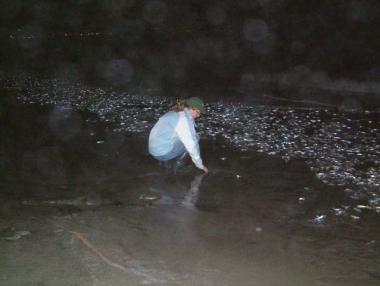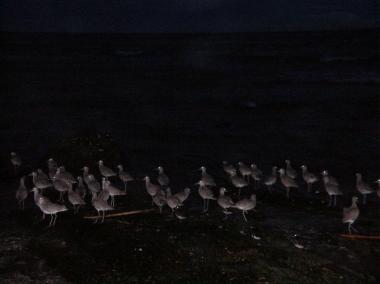Around most urban areas, electric lights on buildings and roads create an all-pervasive glow in the night sky. This light pollution can disrupt the sandy beach and other ecosystems. Plant and animal behaviors affected by artificial light include orientation, navigation, and mating. Photo: Night lights in Santa Barbara, CA. Credit: Carey Batha
Effects of Lighting on Sandy Beaches
- The effects of artificial night lighting on beach ecosystems is not well studied; however, it likely has significant impacts.

Grunion spawn on the beach at night. Constant light from piers or other structures does not necessarily prevent spawning, but the fish may prefer darker or quieter areas of the beaches. Moving flashlights and shining bright lights directly into the water may disturb or stop a spawning run, especially when combined with shore activity and noise. Some runs are more sensitive than others to disturbance.
-
A recent study showed that artificial night lighting can allow shorebirds more opportunity to successfully hunt, helping fuel their long migrations. On the other hand, this hunting advantage may draw them to urban areas, exposing them to other impacts and degraded conditions. Light also may raise their exposure to predators.
-
Studies show that invertebrates, like the critters that dwell in beaches, depend on the cycles of light and dark to signal changes in their behavior. Therefore, altering natural light patters with artificial light could disrupt their feeding, mating, and movement.
-
Though sea turtles do not generally nest in California, they often are mentioned in the context of artificial night lighting. Light can deter female sea turtles from crawling onto the beach to lay their eggs. It disorients new hatchlings as they try to find their way back to the water. Many other beach animals are nocturnal, and their behavior also may be affected by artificial night lighting.

Many shorebirds are attracted to light at night. Since hundreds of species of birds migrate during dark hours, artificial light pollution can slow their migration and even lead to mortality when they collide with buildings and other structures near bright lights.
Lighting at Ormond Beach: Encouraging Results
Ormond Beach is a long, sandy beach backed by degraded wetland. This expanse of mostly undeveloped coastal habitat is rare in Southern California and important for native and migratory birds. One of the only structures in the area, a power generating station, stands prominently in the middle. The Ventura County Shorebird Conservancy conducts regular surveys of snowy plover nests at Ormond Beach. Their data from 2000-2010 indicated at least 20 snowy plover nests located on either side of the generating station, but none in the 1-kilometer stretch of beach directly in front of the station. Hypothesizing that the power plant's nighttime lights were deterring the birds, Conservancy staff spoke to representatives from the power plant and requested that they minimize night lighting. The power plant managers quickly agreed and complied. In 2012 and 2013, about ten nests appeared in front of the generating station. While this evidence is anecdotal, it suggests that a dramatic reduction in night lighting provided better nesting habitat for the snowy plover on Ormond Beach.


![Bright night lights of Long Beach, CA reflecting on the ocean. By Geographer at en.wikipedia (Transfered from en.wikipedia) [CC BY 2.5 (http://creativecommons.org/licenses/by/2.5), GFDL (http://www.gnu.org/copyleft/fdl.html) or CC-BY-SA-3.0 (http://creativecommons.org/licenses/by-sa/3.0/)], from Wikimedia Commons](https://explorebeaches.msi.ucsb.edu/sites/default/files/styles/banner_image/public/images/Downtown_Long_Beach.jpg?itok=k8YYslNR)